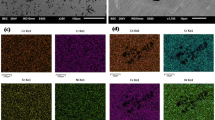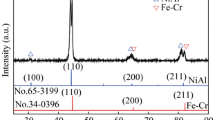The tribotechnical properties of high-entropy alloys in pair with 65G steel in air under dry sliding friction conditions are investigated in comparison with wear-resistant steel and powder materials. The sliding friction rate was 6, 8, and 12 m/sec and the pressure was 0.5 and 1.0 MPa. It is determined that the wear intensity of high-entropy alloys at the sliding friction rate 5–10 m/sec under 0.5 and 1.0 MPa loads ranges from 6.1 · 10–10 g/km to 1.6 · 10–9 g/km for the samples and from 5.5 · 10–8 g/km to 1.1 · 10–8 g/km for the counterface. It is established that, when friction, the shear deformations promote the formation of thermally stable nanostructures with grains 30–70 nm in size in the surface layer of the secondary structures. It is shown that the formation of nanostructures is accompanied with 20–30% increase in hardness for both high-entropy alloys and counterface material. It is established that, when friction, high temperatures at the contact points promote the formation of ordered β-phase with BCC lattice on the friction surface of the Fe25Cr20Ni20 Mn15Co10Al10 high-entropy alloy.






Similar content being viewed by others
References
I. V. Kragel’skii, Friction and Wear [in Russian], Mashinostroyeniye, Moscow (1968), p. 478.
J. W. Yeh, Y. L. Chen, S. J. Lin, and S. K. Chen, “High-entropy alloys—a new era of exploitation,” Mater. Sci. Forum, 560, 1–9 (2007).
S. Ranganathan, “Alloyed pleasures: multimetallic cocktails,” Current Sci., 85, No. 7, 1404–1406 (2003).
S. W. Kao, J. W. Yeh, and T. S. Chin, “Rapidly solidified structure of alloys with up to eight equal-molar elements—a simulation by molecular dynamics,” J. Phys., 20, 1–7 (2008).
S. A. Firstov, V. F. Gorban’, and N. A. Krapivka, “Mechanical properties of multi-component cast alloys at high temperatures,” Sovr. Prob. Fiz. Mater., No. 17, 126–139 (2008).
C.-Y. Hsu, C.-C. Juan, W.-R. Wang, et al., “On the superior hot hardness and softening resistance of AlCoCr x FeMo0.5Ni high-entropy alloys,” Mater. Sci. Eng. A, 528, 3581–3588 (2011).
O. N. Senkov, J. M. Scott, S. V. Senkov, et al., “Microstructure and room temperature properties of a highentropy TaNbHfZrTi alloy,” J. Alloys Compd., 509, 6043–6048 (2011).
S. A. Firstov, V. F. Gorban’, N. A. Krapivka, et al., “Effect of electron density on phase composition of high-entropy equiatomic alloys,” Powder Metall. Met. Ceram., 54, No. 9, 607–613 (2015).
S. A. Firstov, V. F. Gorban’, and E. P. Pechkovskii, New Approach in Processing and Analyzing Results of Automatic Indentation of Materials [in Russian], Logos, Kyiv (2009), p. 82.
S. A. Firstov, V. F. Gorban’, and E. P. Pechkovskii, “Setting limits for hardness, elastic strain, and corresponding stress of materials by automatic indentation,” Materiallovedeniye, No. 8, 15–21 (2008).
N. B. Kostetskaya, “Mechanisms of strain and fracture of friction surfaces in tribooxidizing,” Sverkhtverd. Mater., No. 1, 48–54 (1986).
V. V. Gorskii, “Formation of oxygen-doped Me–Me’–O alloys in contact zone of metals during friction,” Treniye Iznos, 10, No. 3, 452–460 (1989).
V. F. Gorban’, V. F. Britun, and I. A. Kossko, “Changes caused in the composition and structure of flamesprayed chromium coatings by friction due to contact interaction,” Powder Metall. Met. Ceram., 34, No. 5, 299–303 (1995).
M. E. Fleet, “Structure of magnetite,” Acta Crist., B37, 917–920 (1981).
V. F. Gorban’ and E. P. Pechkovskii, “Instrumental indentation for determining the structural state of materials,” Powder Metall. Met. Ceram., 49, Nos. 7–8, 424–429 (2010).
Author information
Authors and Affiliations
Corresponding author
Additional information
Translated from Poroshkovaya Metallurgiya, Vol. 56, Nos. 3–4 (514), pp. 49–58, 2017.
Rights and permissions
About this article
Cite this article
Firstov, S.A., Gorban’, V.F., Krapivka, N.A. et al. Wear Resistance of High-Entropy Alloys. Powder Metall Met Ceram 56, 158–164 (2017). https://doi.org/10.1007/s11106-017-9882-8
Received:
Published:
Issue Date:
DOI: https://doi.org/10.1007/s11106-017-9882-8




